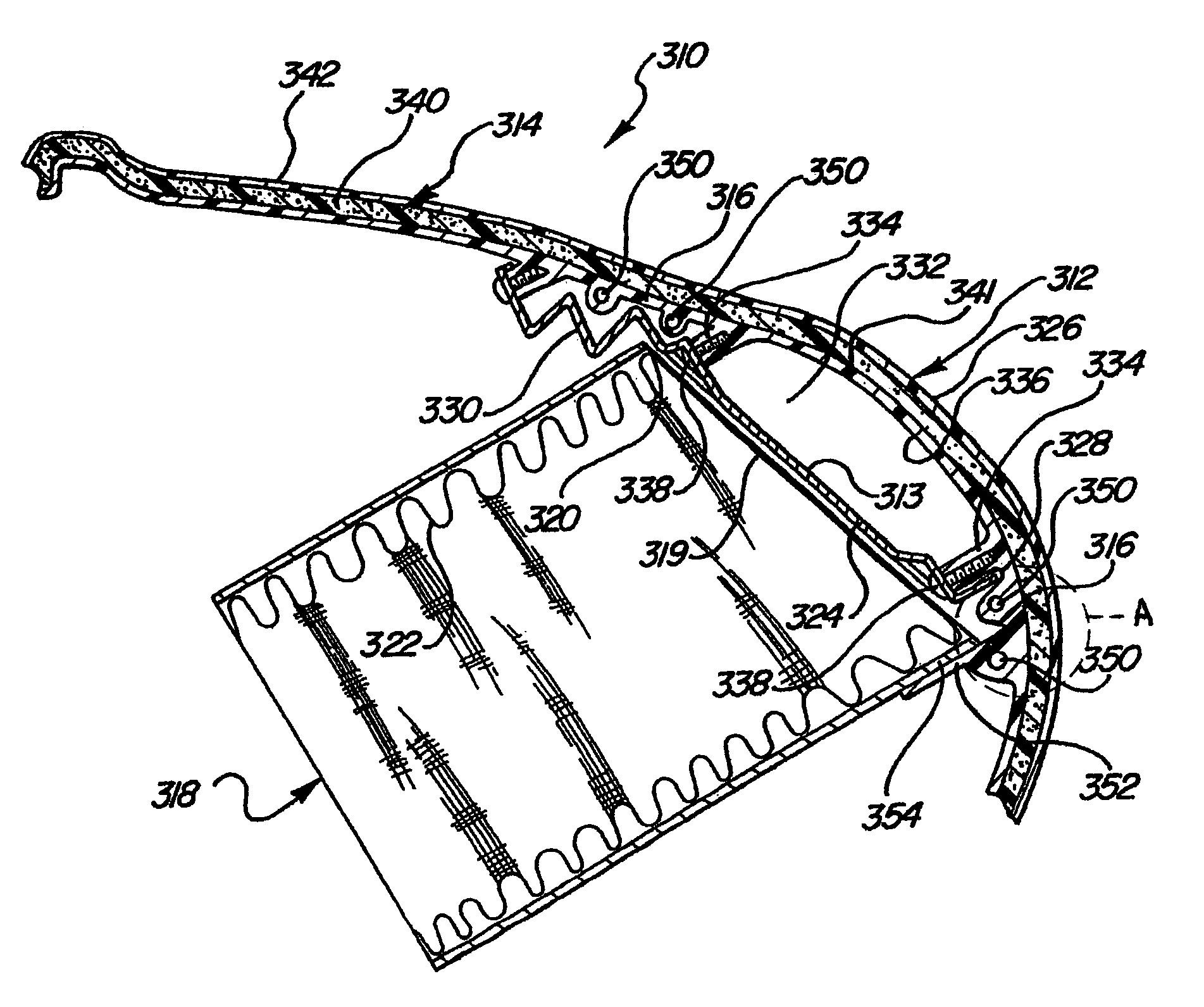Apparatus for deploying an air bag through a hard panel
a technology of airbags and hard panels, which is applied in the direction of pedestrian/occupant safety arrangements, vehicle components, other domestic objects, etc., can solve the problems of door and surrounding instrument panels, easy to break and/or tear seams in integrally formed doors, and the inability of klobucar et al. to disclose airbag doors or any other supplemental inflatable restraint components
- Summary
- Abstract
- Description
- Claims
- Application Information
AI Technical Summary
Benefits of technology
Problems solved by technology
Method used
Image
Examples
first embodiment
[0079]The four fastener brackets 70 that attach the first tether 50′ to the door 16′ extend integrally inward from the door inner surface 38′ adjacent a lower marginal region of the door 16′ to a point adjacent the reaction plate 28′. Similar to the ribs 40 of the first embodiment, the fastener brackets 70 present the reaction plate lower panel 42′ in a plane more perpendicular to the direction of air bag 24′ deployment from the dispenser 20′. In other words, the fastener brackets 70 span the space between the outwardly curved lower marginal door region and the generally vertical reaction plate lower panel 42′.
[0080]The single continuous tether sheet that includes the first flexible tether 50′ also includes a second flexible tether, generally indicated at 80 in FIGS. 4 and 7. The second tether 80 has an inner end portion 82 fastened to the air bag dispenser assembly 20′ at the tether control point 56′. In other embodiments, the second tether 80 may be secured either to the panel 12′...
third embodiment
[0088]According to the invention shown in FIGS. 9–11, the frangible marginal edge 18″ defines the entire perimeter of the air bag deployment door 16″. In other words, the frangible marginal edge 18″ extends completely around the air bag deployment door 16″ in an unbroken circuit as is best shown in FIG. 9. A pair of flexible tethers, representatively indicated at 50″ in FIGS. 10 and 11, is fastened between the air bag deployment door 16″ and the reaction plate 28″. Each tether 50″ includes an inner end portion 82″ fastened to the door 16″, an outer end portion 84″ fastened to the door 16″ and a middle portion 83 fastened to the reaction plate 28″ between the second hinge line 102″ and the reaction plate outer marginal edge 32″. The middle portion 83 of each tether 50″ is disposed approximately midway between the inner 82″ and outer 84″ end portions of each tether 50″.
[0089]The air bag deployment door 16″ includes only four of the fastener brackets 70″ disposed in a rectangular patte...
second embodiment
[0098]As with the first and second embodiment, a generally rectangular reaction plate 28s is attached to an air bag dispenser assembly 20s along a reaction plate inner edge 34s, as shown in FIGS. 12–15. An outer portion 35s of the reaction plate 28s is outwardly pivotable away from the air bag dispenser assembly 20s by bending the reaction plate 28s along a hinge line 36s extending parallel to the reaction plate inner edge 34s. Prior to air bag inflation, the reaction plate 28s is bent at the hinge line 36s approximately 850 downward from horizontal. Following air bag inflation, the reaction plate 28s is bent approximately 850 upward from horizontal.
[0099]Each flexible tether 50s, 51s has a length extending between first and second tether ends, representatively shown at 156 and 158, respectively, in FIGS. 12 and 13. The first and second tether ends 156, 158 of each flexible tether 50s, 51s are fastened to the air bag dispenser assembly 20s adjacent the reaction plate inner edge 34s ...
PUM
| Property | Measurement | Unit |
|---|---|---|
| Angle | aaaaa | aaaaa |
| Force | aaaaa | aaaaa |
| Flexibility | aaaaa | aaaaa |
Abstract
Description
Claims
Application Information
 Login to View More
Login to View More - R&D
- Intellectual Property
- Life Sciences
- Materials
- Tech Scout
- Unparalleled Data Quality
- Higher Quality Content
- 60% Fewer Hallucinations
Browse by: Latest US Patents, China's latest patents, Technical Efficacy Thesaurus, Application Domain, Technology Topic, Popular Technical Reports.
© 2025 PatSnap. All rights reserved.Legal|Privacy policy|Modern Slavery Act Transparency Statement|Sitemap|About US| Contact US: help@patsnap.com



